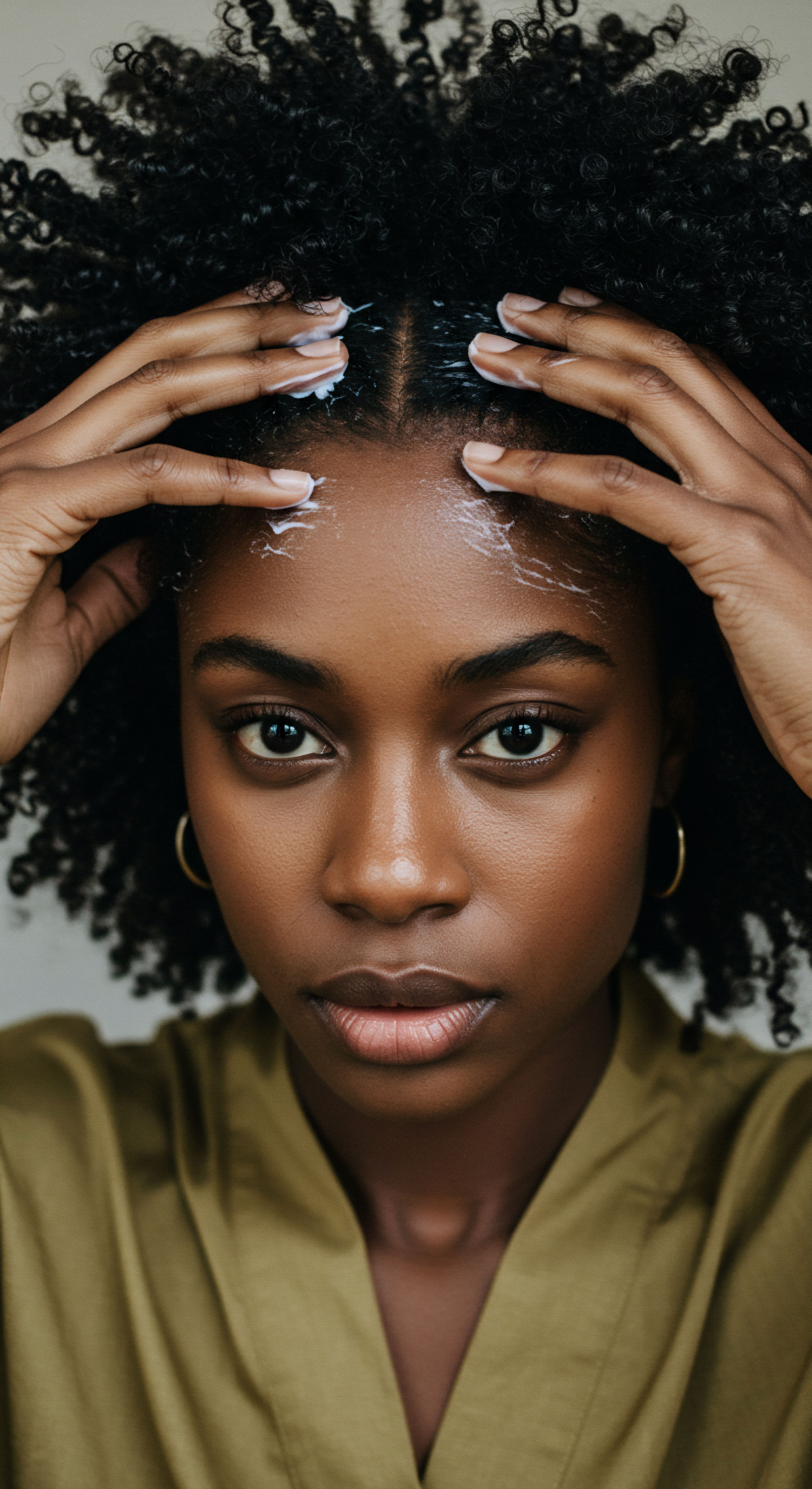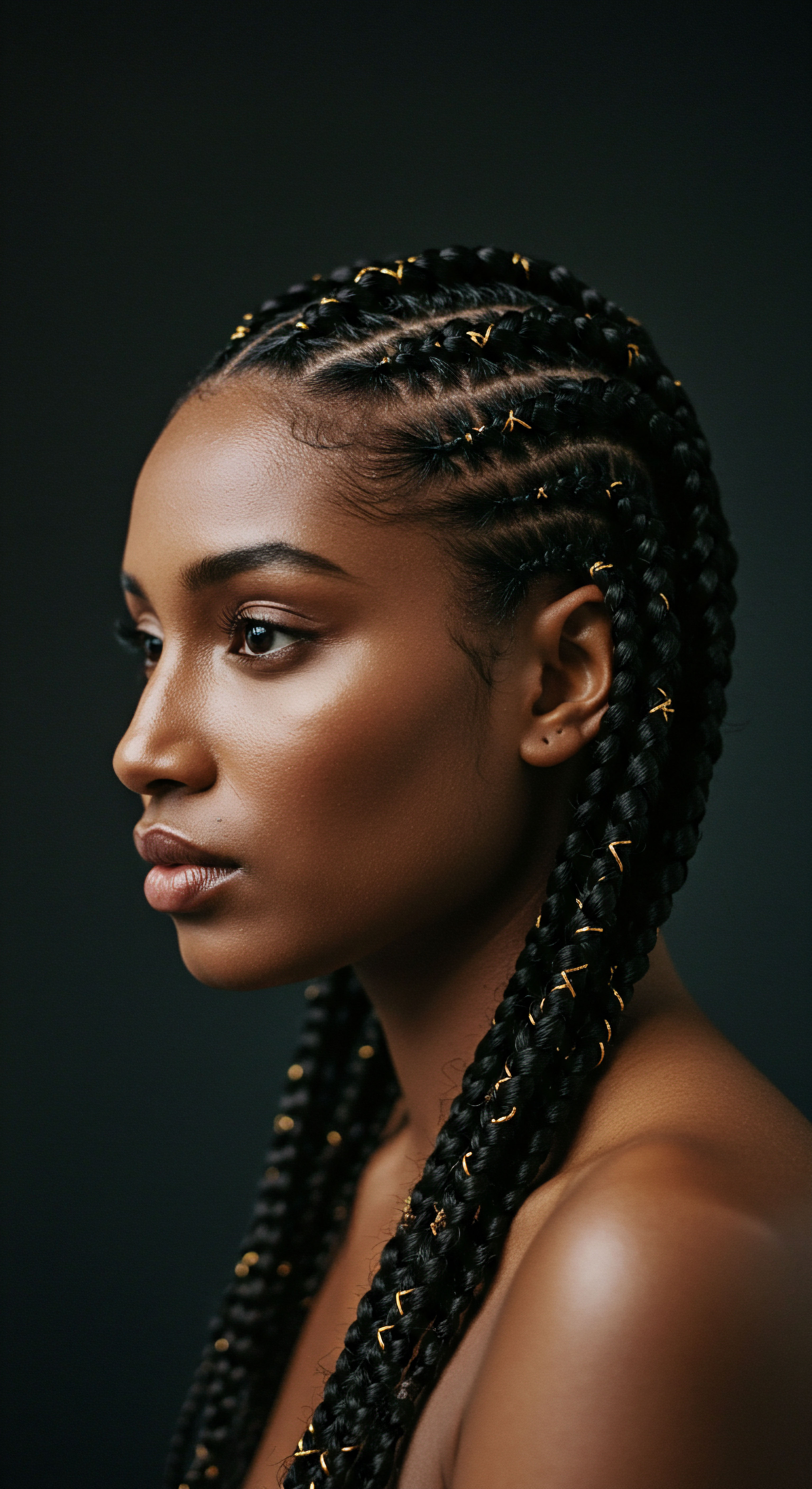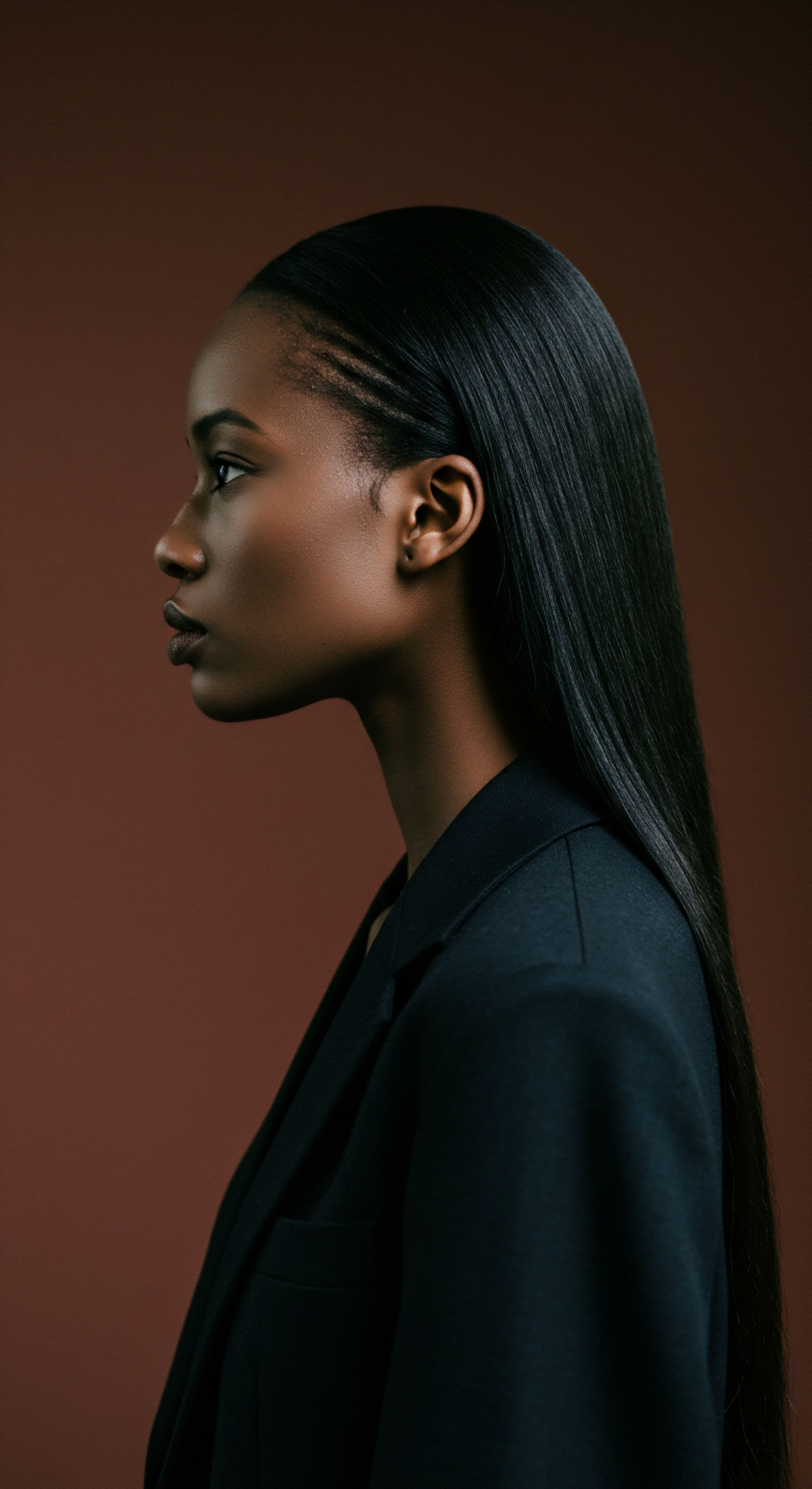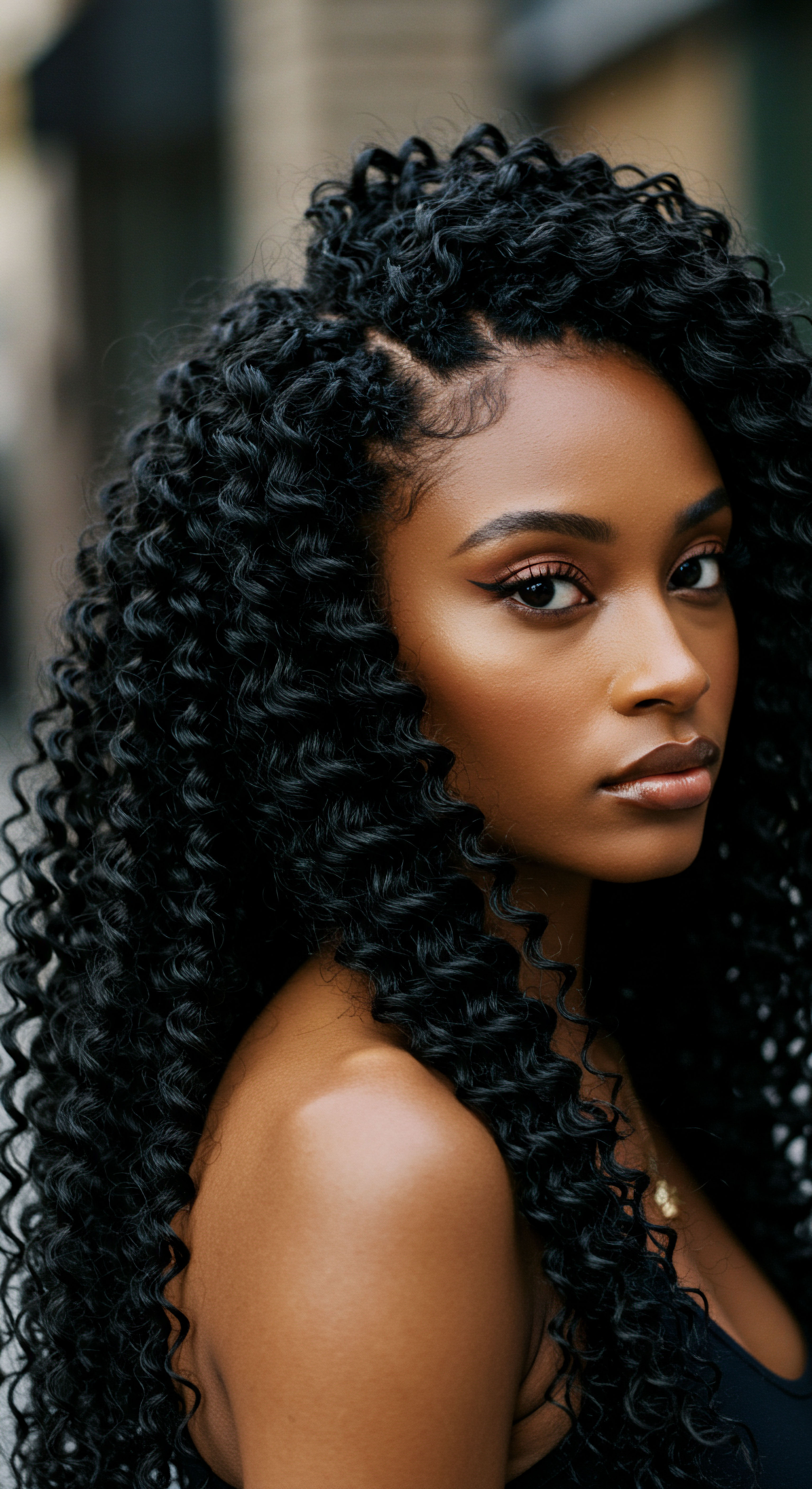
Roots
The whisper of a concern, often felt before it is truly seen, begins at the very edges of our being—our hairlines. For many, this delicate boundary is not merely a frame for the face, but a deeply personal landscape, holding stories of heritage, self-expression, and daily care. When thoughts turn to tight hairstyles, a quiet question often arises ❉ can these acts of adornment, so central to identity, leave a lasting mark, permanently altering the way our hair grows? This exploration invites us to delve into the foundational aspects of hair, to understand its very structure and cycles, providing a grounded perspective on how tension might affect this living, breathing crown.

Hair Anatomy and Physiology Specific to Textured Hair
To truly grasp the potential impact of external forces, one must first appreciate the remarkable architecture of hair itself, particularly textured hair. Unlike straight strands, which emerge from largely circular follicles, textured hair typically grows from elliptical or oval-shaped follicles. This distinct follicular shape is what gives rise to the characteristic curls, coils, and waves, creating a natural inclination for the hair shaft to twist and bend. This inherent curl pattern, while beautiful, also means textured hair can be more susceptible to breakage under mechanical stress, as the bends and twists create points of structural vulnerability.
The hair shaft, primarily composed of keratin protein, consists of three main layers ❉ the cuticle, cortex, and medulla. The outermost layer, the Cuticle, is a protective shield made of overlapping scales. In textured hair, these scales tend to be more lifted compared to straight hair, which can make it feel drier and more prone to tangling and friction. Beneath the cuticle lies the Cortex, which gives hair its strength, elasticity, and color.
The innermost layer, the Medulla, is not always present in finer hair types but contributes to the hair’s bulk and resilience in thicker strands. Understanding these structural differences is vital, as they influence how textured hair responds to tension and external manipulation.
The unique elliptical shape of textured hair follicles and the lifted cuticle scales render these strands more prone to mechanical stress and breakage.

Hair Growth Cycles and Influencing Factors
Hair growth is a dynamic, cyclical process, not a continuous one. Each hair follicle undergoes three primary phases:
- Anagen ❉ This is the active growth phase, lasting from two to seven years. During this period, hair cells divide rapidly, and the hair shaft lengthens.
- Catagen ❉ A brief transitional phase, lasting about two to three weeks, where hair growth stops, and the follicle shrinks.
- Telogen ❉ The resting phase, typically lasting around three months, after which the old hair sheds, and a new anagen hair begins to grow from the same follicle.
Under normal circumstances, approximately 85-90% of hairs are in the anagen phase, 1% in catagen, and 10-15% in telogen. Disruptions to this delicate balance can lead to hair thinning or loss. Factors such as genetics, nutrition, hormonal changes, stress, and certain medical conditions can all sway the hair cycle. When external forces, like persistent pulling from hairstyles, enter the equation, they can profoundly impact the follicle’s ability to remain in its healthy growth cycle, potentially forcing hairs prematurely into the resting or shedding phases.
The integrity of the hair follicle itself, nestled within the scalp, is paramount. The scalp’s health directly impacts hair growth and appearance. Research indicates that oxidative stress from UV rays and pollution significantly impacts scalp and hair health.
A healthy scalp environment, free from excessive inflammation or tension, supports the optimal functioning of these follicles, allowing them to produce strong, healthy strands. When follicles are repeatedly subjected to physical stress, their environment is compromised, setting the stage for changes in growth patterns.

Ritual
As we move from the foundational understanding of hair’s inner workings, our attention naturally shifts to the outer world of practices and styling. Daily choices, whether for aesthetics or convenience, become a ritual, shaping not only our appearance but also the very health of our strands. How do these traditions, particularly those involving tension, interact with the delicate biology of our hair? This section seeks to unravel the practical wisdom surrounding styling, offering guidance with a gentle hand, acknowledging the profound connection between our hands-on care and the long-term well-being of our hair.

Protective Styling Encyclopedia
Protective styles, such as braids, twists, and locs, are celebrated within textured hair communities for their ability to shield delicate ends from environmental exposure and daily manipulation. Yet, the very act of creating these styles can introduce a significant variable ❉ tension. When braids are installed too tightly, or extensions add excessive weight, the hair follicles at the hairline bear the brunt of this force. This constant pulling can lead to a specific type of hair loss known as Traction Alopecia.
The onset of traction alopecia often begins subtly, with slight redness or tenderness around the hairline, sometimes accompanied by small bumps. Over time, if the tension persists, the hair follicles become inflamed and damaged, leading to breakage, thinning, and eventually, permanent scarring of the follicle. This scarring means the follicle can no longer produce hair.
The problem is particularly prevalent among women of African descent who frequently wear tight styles. Studies show a significant prevalence of traction alopecia in these populations, with some research indicating it affects up to one-third of African American women.
The spectrum of protective styles and their potential for tension varies:
- Braids and Cornrows ❉ When pulled taut, especially around the edges, these can exert considerable force. Smaller, tighter braids often present a higher risk than larger, looser ones.
- Wigs and Hair Extensions ❉ The method of attachment is key. Glued-on extensions or wigs secured with tight clips can place immense strain on the underlying hair, particularly if worn for extended periods. The weight of added hair also plays a part.
- Tight Buns and Ponytails ❉ Even seemingly simple styles, if pulled back too severely day after day, can contribute to hairline recession. The constant tugging at the root can cause hairs to shed prematurely.
Tight styles, while offering protection, can introduce damaging tension, leading to hair loss at the hairline.

When Tension Turns to Trauma
The threshold at which tension becomes traumatic is not always obvious, but our scalp often sends clear signals. Pain, itching, small pimple-like bumps, or even a feeling of tightness immediately after styling are all indicators that the tension is excessive. Ignoring these warnings can allow reversible damage to progress to a more enduring state.
Consider the simple act of tying a ponytail. If it leaves an ache at the temples or the back of the neck, it is too tight. Similarly, with braids, if you need pain medication after an installation, the tension is beyond what your follicles can comfortably withstand.
The delicate hair around the edges, often referred to as “baby hairs” or “edges,” is particularly vulnerable due to its finer texture and shorter anagen phase. This area is often the first to show signs of stress from tight styles.
A significant aspect of prevention lies in communication with stylists. Openly discussing comfort levels during styling and advocating for looser installations is paramount. A skilled stylist prioritizes hair health and can adjust techniques to minimize tension without compromising the aesthetic of the style. The adage of “beauty is pain” holds no place when it comes to hair health, as pain often signals damage in progress.
| Sign Scalp Tenderness |
| Description Aching, soreness, or sensitivity of the scalp, especially around the hairline. |
| Potential Impact Indicates immediate stress on hair follicles. |
| Sign Small Bumps |
| Description Red, inflamed, or pus-filled bumps along the hairline or part lines. |
| Potential Impact Suggests inflammation of follicles (folliculitis) due to pulling. |
| Sign Hair Breakage |
| Description Short, broken strands at the roots or along the hairline. |
| Potential Impact Physical weakening of the hair shaft from consistent tension. |
| Sign Thinning Hairline |
| Description Noticeable reduction in hair density along the front or sides of the scalp. |
| Potential Impact Early stage of traction alopecia, follicles are struggling. |
| Sign Painful Braids/Styles |
| Description Discomfort or headaches after styling. |
| Potential Impact Direct indication of excessive pulling force on roots. |
| Sign Recognizing these signals early is key to preventing long-term damage. |

Relay
Beyond the surface, a deeper conversation unfolds regarding the interplay of biological susceptibility, styling traditions, and the profound impact of persistent tension on our hair’s future. How does the body respond to ongoing stress at the hairline, and what does scientific inquiry reveal about the permanence of these changes? This section invites a closer look at the intricate mechanisms of hair loss stemming from external forces, drawing on research and real-world data to paint a complete picture, urging a mindful approach to care that honors both heritage and biological well-being.

How Does Prolonged Tension Affect Follicle Biology?
The hair follicle, a miniature organ embedded in the skin, is remarkably resilient but not immune to chronic physical stress. When hair is consistently pulled tightly, the mechanical force disrupts the delicate environment surrounding the follicle. This prolonged tension can lead to inflammation of the follicle (folliculitis), and over time, a process called Fibrosis. Fibrosis is the formation of excess fibrous connective tissue in an organ or tissue, which in the scalp, can essentially scar the follicle, preventing it from producing hair.
The impact on the hair growth cycle is profound. Constant pulling can prematurely shift hairs from the active growth (anagen) phase into the resting (telogen) phase, leading to increased shedding. If the tension continues, the follicles may miniaturize, producing progressively finer and shorter hairs, until they cease production altogether.
This miniaturization is often accompanied by the loss of the arrector pili muscle, a tiny muscle attached to the follicle, which plays a role in maintaining follicular integrity. Once the follicle is scarred and the arrector pili muscle is damaged, the hair loss becomes irreversible.
The question of permanent alteration hinges on the extent and duration of the damage. In its early stages, traction alopecia is often reversible. If the offending hairstyles are stopped, and the scalp is given time to rest, the follicles can recover and resume normal hair growth.
However, if the tension persists for months or years, leading to significant inflammation and scarring, the damage can indeed become permanent. The hair loss that results from this irreversible follicular damage is known as Scarring Alopecia.

Can Hairline Damage Be Permanent? What Does Research Say?
The evidence points to a clear risk of permanent alteration if tension is sustained. A review of 19 studies published in the Journal of the American Academy of Dermatology confirmed a “strong association” between certain scalp-pulling hairstyles and the development of traction alopecia. This condition, caused by damage to the hair follicle from prolonged or repeated tension on the hair root, is particularly common among African-American women, affecting an estimated one-third of this demographic.
A striking example of this impact comes from a study on South African schoolgirls. Research by Khumalo et al. revealed that the prevalence of traction alopecia in schoolgirls increased significantly with age. Among first-year students, the prevalence was 8.6%, but it rose to 21.7% among those in their final year of school.
This suggests a cumulative effect of consistent tight styling over time, underscoring the potential for long-term consequences on hairline integrity. This progression highlights the biphasic nature of traction alopecia, where early stages are non-scarring and reversible, while chronic cases lead to permanent scarring.
The biomechanics of hair also shed light on this issue. While a single hair strand is remarkably strong, the force required to pull it out at the root is relatively high. The problem arises when this force is applied consistently over many follicles for extended periods, leading to fatigue and eventual damage to the follicle’s anchorage within the scalp. The mechanical stress on the follicle can activate molecular pathways that contribute to its miniaturization and eventual demise.

Cultural Context and Hair Practices
The conversation surrounding tight hairstyles and hairline health cannot overlook the rich cultural significance of many of these styles. For individuals of African descent, hair styling traditions are deeply rooted in history, identity, and self-expression. Styles like cornrows, box braids, and various forms of locs have been passed down through generations, serving as markers of status, community, and beauty.
The challenge, then, lies in navigating the balance between cultural heritage and physiological well-being. It is not the style itself that is inherently damaging, but rather the degree of tension applied and the duration for which it is maintained. Education within communities about gentle styling practices, the importance of breaks between tension styles, and early recognition of warning signs can help preserve both cultural traditions and hairline health. This awareness allows for informed choices that honor ancestry while protecting delicate follicles.

Reflection
The journey through the intricate world of hair, from its microscopic roots to the cultural narratives it carries, leaves us with a profound understanding. The question of whether tight hairstyles can permanently alter hairline growth finds its answer in the delicate balance of biology and consistent care. Our hair, a living part of us, responds to the forces we apply, sometimes with resilience, sometimes with lasting change. May this shared understanding empower us to approach our styling choices with gentle wisdom, celebrating beauty in ways that honor the vitality of our strands and the sacred space of our scalps.

References
- Khumalo, N. P. et al. (2017). “Traction alopecia ❉ A neglected entity in 2017.” Indian Journal of Dermatology, Venereology, and Leprology, 83(6), 644-649.
- Aguh, C. & McMichael, A. J. (2016). “Hairstyles and Traction Alopecia ❉ What Dermatologists Need to Know.” Journal of the American Academy of Dermatology, 74(3), 603-608.
- Samrao, A. et al. (2011). “The Fringe Sign ❉ A New Clinical Feature in Frontal Fibrosing Alopecia.” Archives of Dermatology, 147(11), 1293-1296. (This reference supports the ‘fringe sign’ mentioned in one of the search snippets for TA, showing how clinical signs are studied.)
- Tosti, A. & Schwartz, J. R. (2021). “The Role of Scalp Health in Achieving Optimal Hair Growth and Retention.” International Journal of Cosmetic Science, 43(Suppl. 1), S3-S11.
- Khumalo, N. P. et al. (2019). “Reliability of Histopathology for the Early Recognition of Fibrosis in Traction Alopecia ❉ Correlation with Clinical Severity.” Dermatology, 235(4), 281-286.
- Dabiri, E. (2020). “Twisted ❉ The Tangled History of Black Hair Culture.” Penguin Books.
- Ibhaze, O. L. (2022). “Crowning Glory ❉ A History of African Hair Tradition.” (Self-published/independent, but mentioned in searches for cultural history of hair).
- Rodney, S. (2013). “Fast Facts ❉ Disorders of the Hair and Scalp.” Karger Publishers.
- Alexander, C. (2021). “Hair Disorders ❉ Diagnosis and Management.” Routledge.
- Jayakar, T. (2016). “Hair and Hair Disorders ❉ Diagnosis & Management.” Jaypee Brothers Medical Publishers.